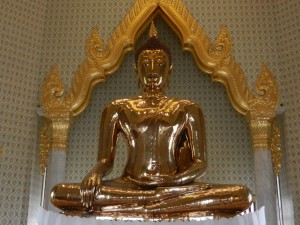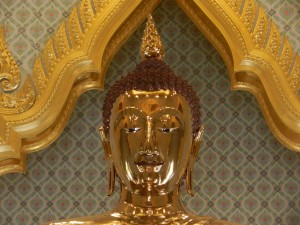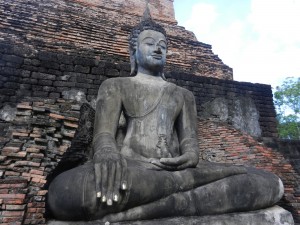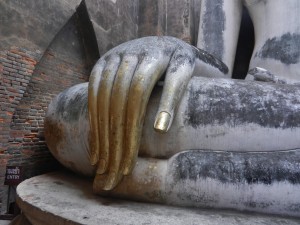While Florentine artists and architects were developing three dimensional perspective in the 15th century, Thai sculptors perfected their own art forms.
They express a different way of seeing the world, but this way is equally fascinating.
The Sukhothai style of Buddhist art is the most honored in Thailand.
The Golden Buddha in Bangkok’s Wat Traimit (the above 2 shots) is one of the most revered statues in this form. Sukhothai artists preferred to portray him in this pose–with his right hand calling the earth as a witness. This is a cool inter-cultural comparison with St. Matthew’s gesturing to the Gospels, from the last post.
The demon Mara was trying to thwart Sakyamuni’s enlightenment–he would have lost his power if the Buddha had taught people how to extinguish their cravings. The soon-to-be Buddha countered his assault by pointing to the earth to prove his merit, which he had earned over hundreds of past lives. A goddess called Dharani, who personified the earth, emerged and wrung her hair. Water from his donations in past lives flooded the ground and flushed Mara and his soldiers away. Sakyamuni then attained enlightenment.
So this statue represents a very auspicious moment, just before Sakyamuni became the Buddha. But the confrontation is made soft. The body’s concave forms flow like a river.
Even the fingers resemble waves. The body has no deep folds in drapery and no muscles to suggest mass. Thais often liked to sheathe the body in bronze or gold–the Buddha in Wat Traimit is solid gold. These metals gleam. They don’t direct your eye to specific features. They radiate energy.
This perspective was influenced by ancient Southeast Asian cultural patterns of living in a tropical environment and settling around rivers. The abundance of life-forms encouraged a sense that the world is infused with animated energy. Thais embraced Buddhism as they liberated themselves from the Khmers in the 13th century and built their own states. Over the next 200 years, artists perfected ways of synthesizing this sense of nature’s power with the Buddha’s compassion.
Just after reaching enlightenment, the Buddha softly smiled. The Sukhothai style’s face is all grace. Nothing confrontational. No flowing beard or leering eyes. Every square inch flows as softly as the fingers.
These gentle art forms have helped Thai society cohere–its people value fun over confrontation. These forms don’t convey as much information about details as Florentine sculpture and painting do, but they’re rooted in an equally ancient and rich cultural landscape. Their beauty can give you many reasons to smile.






Comments on this entry are closed.